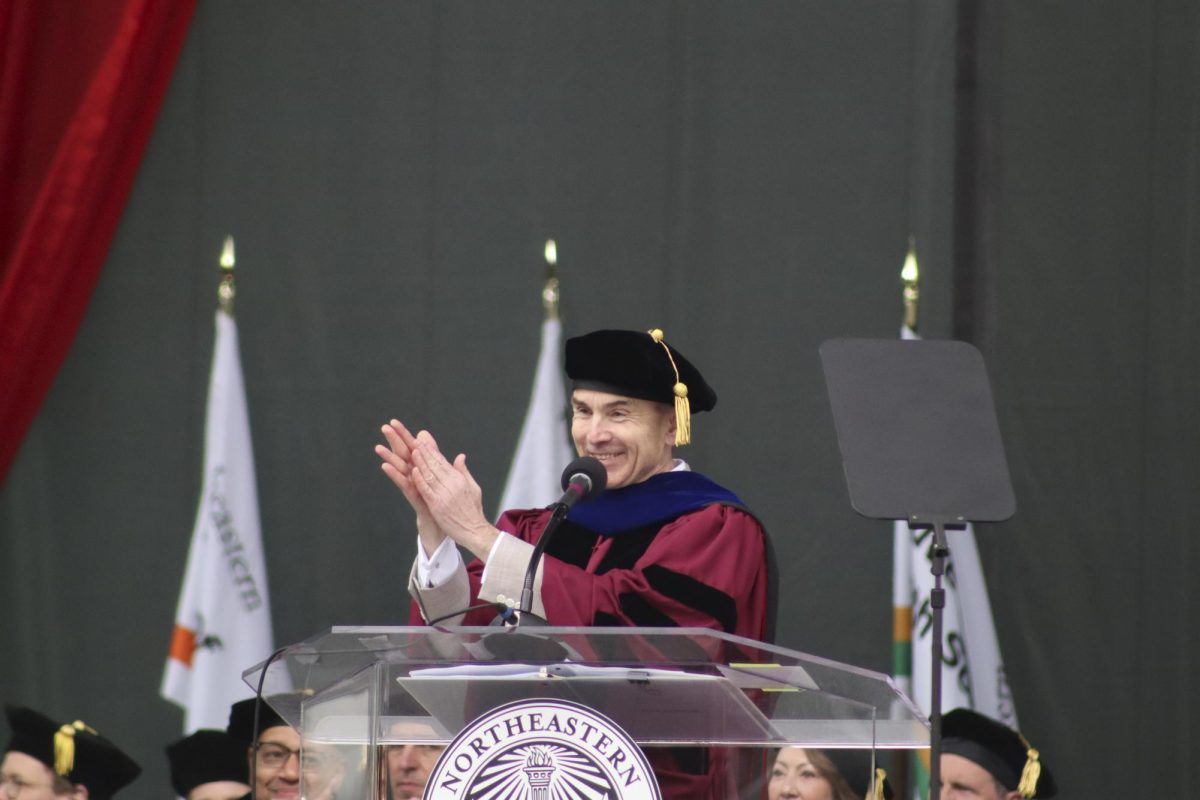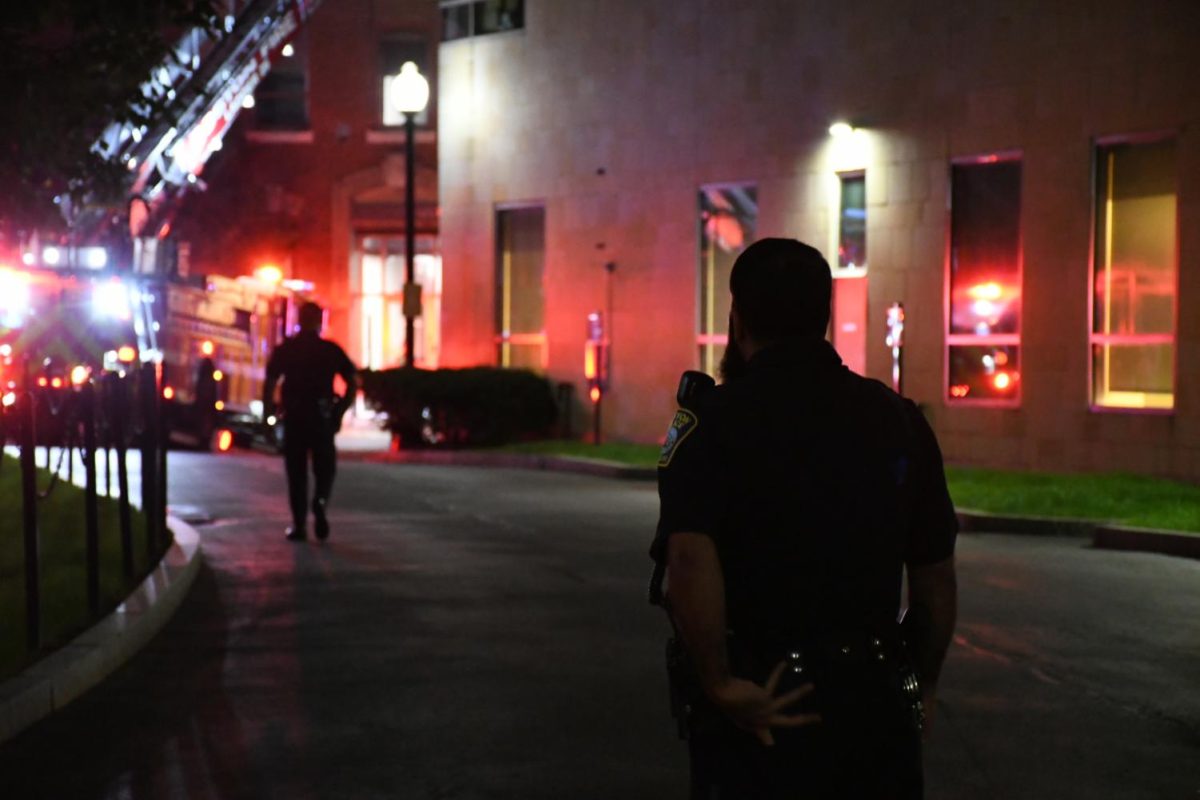The News published the original version of this article on March 25 with a misquotation due to audio transcription errors. This version contains the corrected quotation. The News regrets the error.
The fourth academic year of President Joseph Aoun’s tenure — marked by the third anniversary of his inauguration tomorrow — was characterized by dramatic change within the university.
Some changes met resistance from students, faculty and staff. But, Aoun said in an interview with members of The News’ executive board Monday, an institution is constantly changing.
“Every institution goes through change,” he said. “If an institution is not changing that means an institution is not looking at opportunities and realities.”
Recent Developments
The change that illicited the most tension with students was the announcement of an official four-year, two co-op option.
In a Boston Globe article announcing the new four-year option on Dec. 9, Aoun was reported saying he predicts that within three years, the four-year option will “spread like wildfire” and that he predicts the majority of students will finish in four years. However, in a recent interview, Aoun said that both pieces of information were taken out of context.
Students met the announcement with resistance, arguing that the five-year program is what defines Northeastern. Some students argued that the introduction of a four-year track, when most students could already graduate in four years regardless, was a ploy to phase out the five-year option, thus streamlining the university.
This sentiment was most directly personified in the Facebook group Fight For Five. The group now stands at roughly 6,200 members. A petition they promised to take to Aoun if it obtained 5,000 signatures now has 3,298.
“What does it tell me?” Aoun asked in an interview with members of The News’ editorial board Monday. “It tells me that people are passionate about Northeastern, about their alma mater. So that’s what I like … When people are passionate sometimes passion drives you to not see the whole picture, but people are passionate and I love that. So that’s the good aspect.”
To combat resistance and what administrators thought were misconceptions, Aoun sent an e-mail to students titled Co-op Innovation. In the e-mail he wrote that neither option was designed to supercede the other and that the four-year track was designed to increase the flexibility and options students have. He also announced that a series of forums were to be held with the deans of each college to address four-year option related concerns.
Participation in the forums varied from roughly 15 students in the college of business administration to nearly 200 at the Bouve College of Health Sciences forum. However, discussion focused more on adapting programs to fit the four-year model. Fight For Five’s argument alleging the malicious intent of the four-year option was not voiced.
Earlier in the year, the College of Arts and Sciences and the College of Criminal Justice were dissolved into the College of Art, Media and Design, the College of Sciences, and the College of Social Sciences and Humanities.
Some students, especially those in the College of Criminal Justice, which was dissolved into the College of Social Sciences and Humanities, were not happy with the change.
“Personally, I think it’s probably one of the worst decisions the university could make,” The News reported middler criminal justice major Rachel Feinstein saying in Jan. 2009. “People come to Northeastern to be part of the College of Criminal Justice.”
Recently the Provost announced that those students who were a part of the College of Criminal Justice or Arts and Sciences will have the option of having that printed on their diploma instead of one of the new three.
Aoun said the restructure was a major improvement to the university.
“Now I can tell you, the change, some people by definition welcome the change and see opportunities in it, some people are going to resist it,” he said.
Another area of concern with students was the termination of the football program in November.
Students, especially those involved with the program, were unhappy with the decision. Shortly after, a small number of students protested outside the Cabot Physical Education Center.
In a recent interview, Aoun said that, although it was a difficult decision, the football program was cut because it did not align with the university’s goals.
“We felt that we felt that in this domain what frankly has been happening in terms of supporting football has been getting to be so non-commentary with what a university like ours should do,” he said.
He continued by saying that the program was beginning to cost too much money.
“We cannot, in a period of economic retrenchment, see ourselves investing 10s and 10s of millions of dollars,” he said.
University Growth and The Money
Richard Freeland, the president before Aoun, stepped down on Aug. 14, 2006, after a decade-long incumbency. Aoun moved in two days later.
Freeland entered the university at a time when the graduation rate was 39 percent. By the spring of 2005, when he left, the graduation rate was 61 percent and the average SAT score of the incoming freshman class had risen by roughly 200 points.
Freeland also oversaw the construction of the Marino Center, the West Village Residence Halls and many academic buildings, including the Behrakis Health Science Center.
Before Freeland left, he set a goal for the university: breaking into the U.S. News and World Report’s annual ranking of the top 100 American colleges. In 1995, Northeastern ranked 162. In the spring of 2005, it ranked 115. At his time of departure, Freeland said he felt confidant Northeastern would break into the top 100 within “two or three years.”
His estimate was largely correct. Five years later, Northeastern holds the 80 spot in the U.S. News and World Report’s rankings.
Freeland left the university at a time of considerable growth, a growth he had a large part in fostering.
“I think of institutions as sort of a trajectory, a course of evolution, and as president, you need to think of where an institution is in its particular trajectory,” Freeland said in an interview with The News in 2006. “What Northeastern needed from me as president, more than anything else, was what I refer to as a ‘repositioning,’ getting firmly established as a top-tier selective university.”
However, Freeland admitted that alumni relations – or, more specifically, alumni financial support – was an area in which the university needed improvement. And economics professor Oscar Brookins said in an interview with The News that raising funds is an important part of a university president’s job.
“In most institutions, the president of the university is the point person, whose job it is to cultivate this process of successful alums and just successful passersby who decide ‘I have lots of money now, and there’s Northeastern over there, I’ll give them some of my money,’” he said. “We haven’t had a lot of that from our presidents, including the one we have in office now.”
The university’s endowment was little more than $500 million at the beginning of the 2005 academic year, when Freeland announced his resignation. Mark Putnam, the director of planning and research at the time, said the endowment was lower than other private universities of equivalent size.
At the University of Southern California (USC), Aoun was dean of the College of Letters, Arts and Sciences for six years before taking the helm at Northeastern. There, he was widely seen as a successful fundraiser, according to Chronicle of Higher Education reports.
The Chronicle of Higher Education reported that in 2001, Aoun raised $28 million for his college; $31 million in 2002 – both above the $18 million average in years past. In 2005 – a year before he would take over at Northeastern – he courted a 10 million dollar donation from a Los Angeles businesswoman.
Northeastern’s endowment was on a steady rise from a 2003 low point of $430 million to a $700 million peak in 2007, the first full year of Aoun’s term.
However, the second and third full years of Aoun’s presidency have shown a marked decline in endowment figures. In 2008 the endowment dropped to $673 million and in 2009 it dropped to a little more than $500 million, a figure closer to the 2003 low point during Freeland’s term than the 2007 peak.
Colleges and universities across the country are seeing a decrease in their endowment, largely because of the stock market, as endowment funds typically get tied into bonds and investments, Brookins said.
But, he continued, Northeastern has never had a large endowment compared to other institutions of similar size, most of which have endowment statistics in the billions.
“We’re new to the game and far behind, relative to our size, certainly,” he said. “And in an absolute sense, we are barely a player as far as endowments in higher education institutions goes around the country.”
Another trend, at least in the Boston area, is the increase of university president’s salaries. Aoun is one of several Boston-area university presidents to have taken a pay raise for the 2008-2009 academic year.
In November, The News reported that Aoun’s salary went up 25 percent from $589,663 in 2007 to $737,863 in 2008. Aoun’s salary for the 2009 fiscal year has yet to be released, but the university’s non-profit status requires it to do so.
Coupled with that, Northeastern announced in March of 2009 that tuition would raise 4.9 percent, to $34,950, for the 2009-2010 academic year.
In September of 2007, the university purchased a five-story, 8.9 million dollar townhouse on Beacon Street to serve as the president’s home.
“The trustees wanted to have a place that would be a statement that the school is part of the city,” Aoun said in a Q&A with the Financial Times Jan. 30.
Aoun’s Direction
Apart from his financial prowess, Aoun brought a specific path and plan for the university.
“Both men have had great visions,” William Folwer, a history professor, said, referring to Aoun and Freeland. “Aoun’s vision is a global one.”
His inauguration speech on March 27, 2009, touched on five major areas he wanted to improve: building partnerships with other institutions, the status of international co-op, interdisciplinary research, the strength of arts and humanities programs and the university’s “urban engagement.”
Above all else, Aoun has emphasized the international status of the university.
“International experience has always been a theme but Aoun has brought it to the fore,” William Fowler, a professor of History that has served as a student and educator under five Northeastern presidents, said. “He sees it as an avenue to improve the university’s stature.”
In his inauguration address, Aoun promised to double the number of international opportunities by September 2007. Director of Communications Renata Nyul said that, at this point, the amount of locations in which international opportunities are offered have “more than doubled.” She did not comment on the amount of students overseas.
“We will continue to expand the reach and scope of international co-op until our students can be found in all corners of the world,” he said.
In his state of the university address on Sept. 30, 2009, Aoun defined the 2009-2010 academic year as the “year of global experience.”
He then announced that a new scholarship, The Presidential Global Scholars Initiative, that would fund an international experience for a few hundred students. A small sect of those students would win a Global Fellowship, which would provide “up to a full tuition scholarship” for the remainder of the recipients undergraduate degree.
The model effectively replaces the Presidential Scholarship, which awarded eight to 10 of the brightest Northeastern students full-tuition scholarships for their junior and senior years.
Aoun’s term has also seen an increase in the popularity of the Dialogues of Civilization program, which allows students to spend a summer session over seas with a professor taking two classes and earning eight course credit hours.
Philosophy professor Steve Nathansen said he felt the push for international experience was a good direction for the university.
“We live in a more globalized environment, so I think that’s a quite a good thing to try to make a northeastern education appropriate and adequate in a more globalized world,” he said.
In Monday’s interview, Aoun said his objective now is to continue and to capitalize on the the university’s “momentum.”
“So what we said, what was most important for us and for me to preserve is the momentum and how to accelerate it, especially at a period when others are retrenching,” he said.
He continued by saying that while other universities were “retrenching” and cutting funding, Northeastern has hired 43 new faculty members.
Bureaucracy and organizational structure
Since Aoun’s entrance, the face of the administration, both in who composes it and how it operates, has changed.
In the 2005-2006 academic year, the last year of Freeland’s term, the administration comprised of 37 members, as listed in official organizational charts. Now, it stands at roughly 50.
Gerald Herman, a longtime history professor and member of faculty senate, said the university has grown increasingly bureaucratic.
“There’s a whole issue about hierarchy,” he said. “Northeastern was traditionally a place where anyone could talk to anyone. We seem to be much more aware of lines of authority now.”
However, Aoun said he feels the university should have a defined hierarchy.
“Let me give you an example,” he said. “If somebody tries to make a request and make an agreement directly with the provost without going to the chair and going to the dean, the chair and the dean are not going to feel a part of the equation and the responsibility. We cannot afford agreements to be done in this way.”
Senior Vice President of External Affairs Mike Armini said that giving deans more jurisdiction will help future dean search processes because increased jurisdiction will make candidates “feel empowered,” thus more likely to take the job. He also said that Northeastern is heading in a more “college based” approach, and giving deans and department chairs more power is a step in that direction.
In October 2007, Aoun appointed Mary Loeffelholz to serve as a liaison between him and faculty, as previously reported in The News. The decision was in response to members of the faculty senate complaining of “strained relations” between him and faculty. Faculty senate was not consulted before the decision was made.
In June 2008, Stephen Director became the provost, the position that effectively controls the academic side of the university.
Herman said that recently the responsibilities of the president and provost have shifted, giving the provost academic “center stage.”
“It has to do with thinking of the appropriate roles at individual levels and the economy,” he said. “The president has to spend more time on fundraising, he has to back away from the day-to-day management.”
Some faculty members said they felt that, as of late, faculty’s voice has been heard less.
“Northeastern has a longstanding commitment to faculty involvement in university governance, more so than other schools. However, recently, there seems to be a diminishing role in faculty involvement, in the face of what I would call authoritarian decision-making,” said a faculty member who wished to remain anonymous due to occupational hazards.
The faculty member cited the way dean search committees were formed and salaries allocated as specific instances.
However, Aoun said he feels faculty members play a major role.
“They shape the agenda,” he said.
Transparency and Visibility
Some students felt that Freeland was not a public enough figure and that the new president should be more personable, The News reported in June 2008.
And, for the most part, Aoun was, Professor Herman said.
“Joseph tried very hard at the onset, he was very open,” he said.
However, Professor Fowler argued Aoun has become less visible as of late, due in part to the commands of his job.
“I think to some degree, in year 2010, the complexity of his job is greater than other presidents,” he said. “The simple pace of his job makes him move at a rapid speed, and it makes it seem like he doesn’t have time.”
But, he said, if students don’t think he’s being transparent, they “need to speak up.”
Part of Fight For Five’s mantra, listed on its Facebook page, is to “help provide Students a voice in the decision making processes for large changes to the University.”
And, as shown before, Fight For Five has garnered administrative attention with the four-year option forums held by the deans. Fight For Five is currently calling for similar styled meetings with the president and provost.
Aoun has held three meetings with students in the past year called “Conversations.” They are one to two hour topic-based discussions with 15 to 20 students selected and contacted by the deans and the office of student affairs. The meetings have focused on leadership, global opportunities, and the concept of a student-centered university, respectively.
Aoun also said he takes time to talk to students while walking around campus.
“The other day when we announced the four year co-op option, I was at Stetson,” he recalled. “I sat down with students, we were talking, and somebody said, ‘Is the four year co-op option going to displace the five year?’ I said ‘No,’ he said ‘Fine.’
In Monday’s interview, Aoun said a goal for the future is to take advantage of online oportunities in reaching out to students. He said that he’ll “explore new media” and is not opposed to creating a twitter account.
Outside of that, Aoun said he will continue to foster the university’s momentum and growth while staying true to the university’s “teaching and research missions.”









